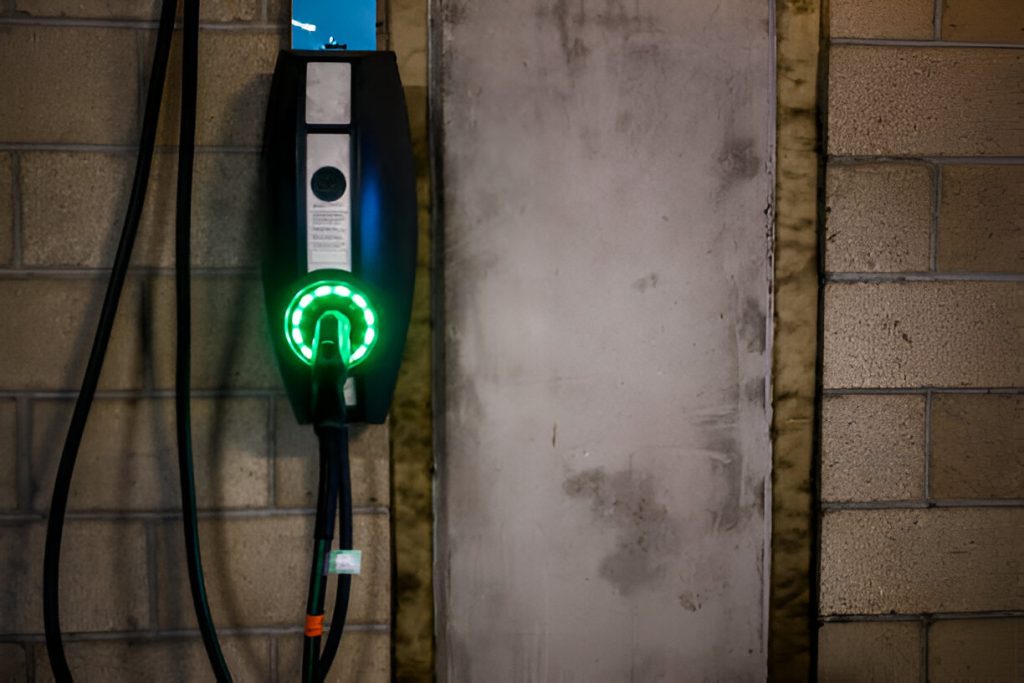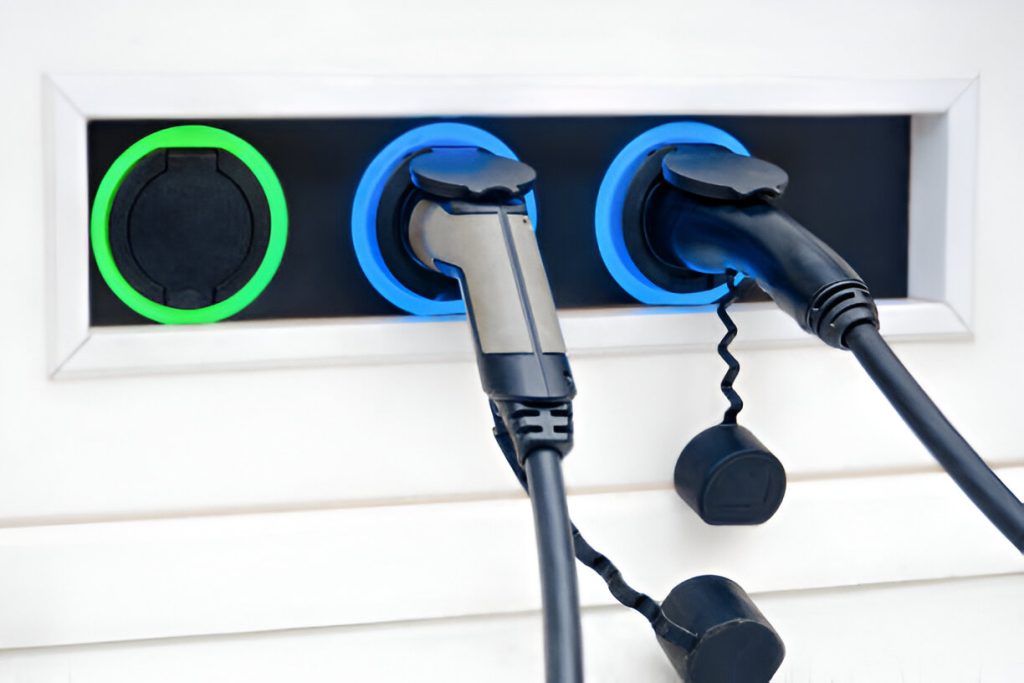
Electric vehicles (EVs) use different charging levels to charge their batteries. It’s important to know about these levels so you can make the most of your EV:
● Level 1 Charging: This uses a regular 120V outlet and charges at a slower rate.
● Level 2 Charging: This operates at 208-240V and is much faster than Level 1.
● Level 3 Charging (DC Fast Charging): This is the quickest way to charge your EV, using direct current (DC).
In this guide, we’ll focus on Level 2 EV charging. We’ll explain what it is, why it’s beneficial, and where it’s commonly used. Whether you’re thinking about getting a Level 2 charger for your home, or workplace, or using public charging stations like those found in business parks, this guide has all the information you need.
By the end of this guide, you’ll understand how Level 2 charging can improve your experience as an EV owner. If you’re located in London or Surrey in the UK and looking for reliable electric vehicle charger installers, we have got you covered with our fast and safe services.
The Advantages and Applications of Level 2 Charging
Level 2 chargers offer significantly faster charging speeds compared to Level 1 chargers. While Level 1 chargers typically provide around 4 to 5 miles of range per hour, Level 2 chargers can deliver between 10 to 75 miles of range per hour in the U.S., and up to 22 kW in Europe. This enhanced efficiency makes Level 2 charging an attractive option for many EV owners.
Benefits of Using Level 2 Charging at Home
● Convenience: Charging your EV overnight ensures that you start each day with a full battery.
● Cost-effective: Home electricity rates are usually lower than public charging stations, resulting in cost savings over time.
● Time-saving: Faster charging times reduce the need for frequent, lengthy charging sessions.
Installing Home EV Chargers For Homes in London & Surrey is a practical step towards reaping these benefits.
Workplace Charging Advantages
● Employee Convenience: Providing Level 2 chargers at the workplace means employees can charge their vehicles during work hours, reducing stress about finding public charging stations.
● Attracting Talent: Offering EV charging solutions can be a perk that attracts environmentally conscious employees.
● Sustainability Goals: Companies can meet corporate sustainability goals by facilitating eco-friendly commuting options.
Commercial EV Charger Installation | EV Business & Fleet Charging Solutions is essential for businesses looking to leverage these advantages.
Public Stations and Community Impact
● Accessibility: Strategically placed public Level 2 chargers make it easier for EV owners to maintain their vehicle’s charge without planning extensive detours.
● Economic Growth: Installing public chargers can attract more visitors to commercial properties such as retail parks and restaurants, boosting local business.
● Environmental Benefits: By supporting the transition to electric vehicles, communities contribute to reduced greenhouse gas emissions and improved air quality.
Level 2 chargers bridge the gap between slow home charging and rapid DC fast charging, providing a versatile solution suitable for various environments. Each setting benefits from the speed and convenience that these chargers offer, making them a pivotal component in the overall infrastructure for electric vehicles.
Understanding the Technical Aspects
Level 2 EV charging systems operate at 208/240V, significantly higher than the standard 120V used by Level 1 chargers. This increased voltage allows for faster charging times, making Level 2 chargers a popular choice for both residential and commercial applications.
Voltage Requirements
● 208V: Commonly found in commercial settings, particularly in the United States, where businesses often have three-phase power supplies.
● 240V: Typically used in residential environments. Many homes with electric dryers or other high-power appliances already have 240V outlets, facilitating easier installation of Level 2 chargers.
Phases in Level 2 Charging Systems
● Single-Phase Power: Predominantly used in residential settings across the U.S. and Europe. Single-phase power is sufficient for most home charging needs, offering a balance between speed and installation cost.
● Three-Phase Power: More common in commercial and industrial environments, especially in Europe. Three-phase systems can deliver higher power levels, enabling even faster charging rates.
By understanding these technical aspects, you can better determine which type of Level 2 charger will best meet your needs. Whether you’re looking to install a charger at home or a workplace, knowing the voltage and phase requirements ensures you select the appropriate system for optimal performance.
Key Differences from Other Charging Levels
AC vs. DC Charging
Level 2 charging is an AC-based system. The electricity supplied by the power grid is in an alternating current (AC) format, which is then converted into direct current (DC) by the onboard charger of the electric vehicle (EV). This DC power is what ultimately charges the EV’s battery.
In contrast, DC fast charging (Level 3) bypasses the vehicle’s onboard converter and directly supplies DC power to the battery, allowing for much quicker charging times.
Overview of Charging Speeds: L1 to L3
Understanding the different levels of EV charging speeds is crucial:
Level 1 (L1):
● Uses a standard household outlet (120V in the US).
● Provides around 2-5 miles of range per hour.
● Ideal for overnight home charging but very slow.
Level 2 (L2):
● Utilises a higher voltage outlet (208-240V in the US).
● Delivers between 3 to 19.2 kW of power, translating to about 10-75 miles of range per hour.
● Suitable for home, workplace, and public stations due to its balanced speed and convenience.
Level 3 (L3):
● Known as DC fast charging.
● Operates at much higher voltages and currents.
● Can provide up to hundreds of miles of range within minutes, making it ideal for long-distance travel and highway rest stops.
Recognising these distinctions helps you choose the right charging solution based on your needs and driving habits.
Exploring Level 2 Charging Connectors
Level 2 charging connectors are an important part of the EV charging infrastructure. They make sure that different areas can work well together and be efficient. Here’s an introduction to the most common types:
Type 1 (J1772)
Type 1 connectors, also known as J1772, are very common in North America and Japan. They offer a reliable connection for Level 2 AC charging and you can find them in both homes and public charging stations.
Type 2 (Mennekes)
In Europe, Australia, the Middle East, and Africa, the Type 2 connector (also called Mennekes) is the standard for Level 2 charging. This connector supports single-phase and three-phase power, making it useful for different charging needs.
GB/T
China uses the GB/T connector for its Level 2 charging infrastructure. This type is made specifically to meet China’s standards and rules, so it works well with the country’s EVs.
NACS by Tesla
Tesla made its connector standard called NACS (North American Charging Standard). It’s mostly used with Tesla vehicles in North America, but there are adapters available to use it with other EV models too.
It’s important to know about these connectors so you can choose the right Level 2 charger that works with your vehicle and follows your area’s standards.

Ideal Locations for Installing Level 2 Chargers
Selecting ideal Level 2 charger locations is crucial for maximizing convenience and accessibility. Different settings offer unique benefits, making it essential to tailor the installation to the specific needs of the users.
Home Charging
For many EV owners, home charging provides unmatched convenience. Installing a Level 2 charger at home allows you to charge your vehicle overnight, ensuring it’s ready for daily use. This setup works well in residential garages or driveways, where access is straightforward.
Workplace Charging
Workplace charging supports employees who drive electric vehicles by providing them with a reliable place to charge during work hours. This can significantly increase the daily range of an EV, making it easier for employees to commute without range anxiety. Employers can install chargers in parking lots or designated charging areas to facilitate easy access.
Public Charging Stations
Public charging stations serve a broader community by offering accessible charging points in high-traffic areas. These can be strategically placed in:
● Community centers
● Parks
● Event venues
● Leisure centers
● Roadside rest stops
Public installations cater to those who do not have access to home or workplace chargers and ensure that EV drivers can maintain their charge during longer trips.
Commercial Properties
Installing Level 2 chargers at commercial properties offers additional convenience for visitors and customers. Retail parks, restaurants, long-stay car parks, and hotels benefit from providing charging options, enhancing customer satisfaction, and attracting eco-conscious patrons.
Considering these diverse locations and their specific requirements ensures that Level 2 chargers are both accessible and convenient, supporting the growing adoption of electric vehicles.
Incentivizing the Transition to Level 2 EV Charging
Financial incentives significantly boost the adoption of Level 2 charging infrastructure. Various programs offer substantial support in the form of tax credits, rebates, and grants. These incentives help alleviate the initial costs associated with purchasing and installing advanced chargers.
Common Financial Incentives:
● Tax Credits: Governments often provide tax credits to offset a portion of the installation costs. For instance, in the United States, federal and state-level tax incentives encourage individuals and businesses to invest in Level 2 chargers.
● Rebates: Utility companies frequently offer rebates to customers who install Level 2 chargers. These rebates can cover a significant percentage of the charger’s cost, making it more accessible for everyday use.
● Grants: Various grants are available for both public and private entities aiming to establish EV charging stations. These grants often target workplaces, commercial properties, and public spaces to promote widespread EV adoption.
Power-Sonic Corp and Elite Vehicle Chargers have extensive experience navigating these financial programs, helping clients maximize their benefits while transitioning to efficient Level 2 EV charging solutions.

Conclusion
Using Level 2 EV charging can greatly improve your electric vehicle experience. It offers faster charging speeds and can be used in various settings such as homes, offices, and public charging stations, making it a convenient and efficient option for EV owners.
Power-Sonic Corp, along with its division Elite Vehicle Chargers, is a trusted provider of high-quality Level 2 chargers. With their extensive expertise and commitment to excellence, they offer top-notch products that cater to different charging requirements.
If you’re interested in experiencing the benefits of Level 2 EV charging, Power-Sonic Corp and Elite Vehicle Chargers have a wide range of solutions available. These solutions are designed to meet the current and future needs of electric vehicle infrastructure.
